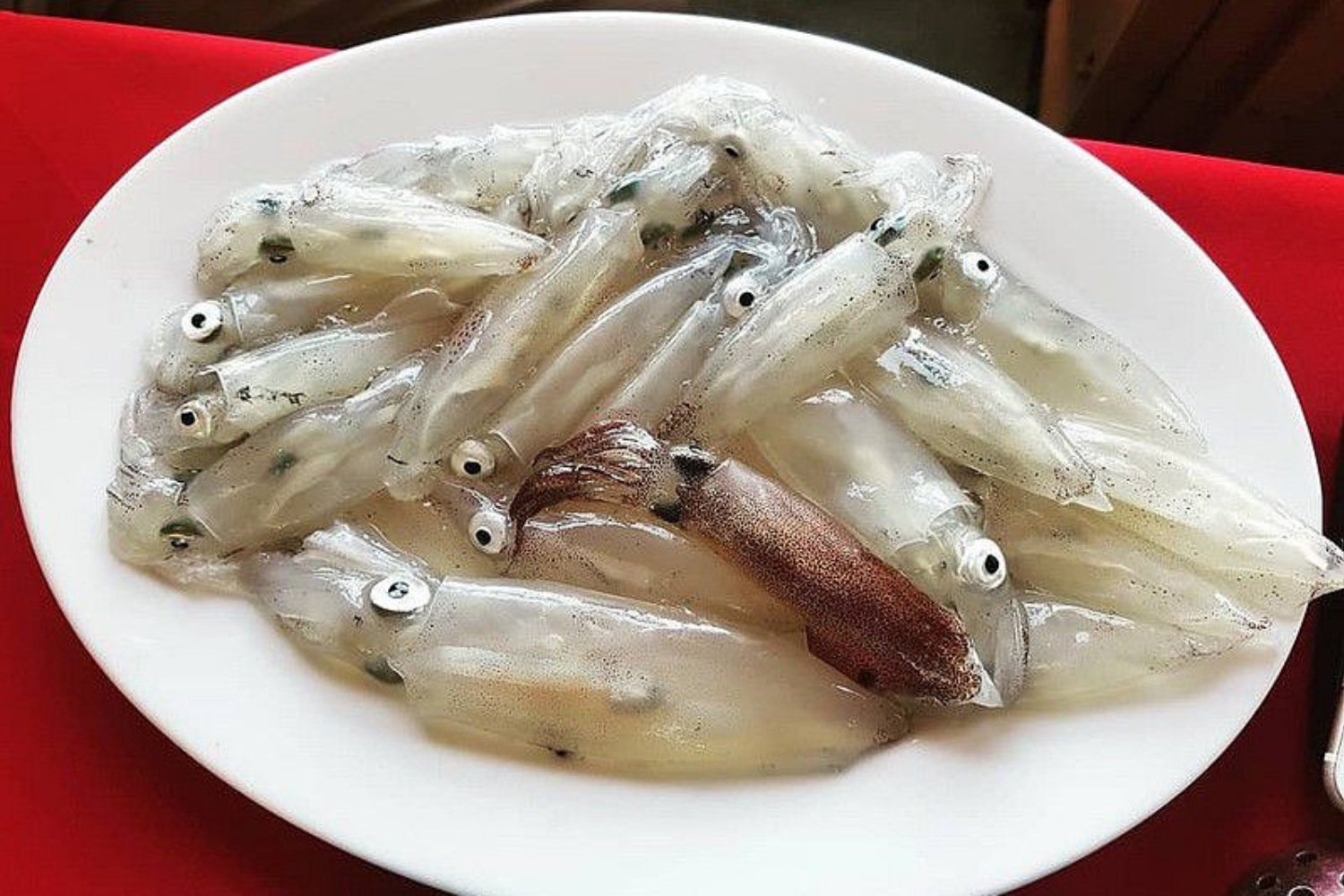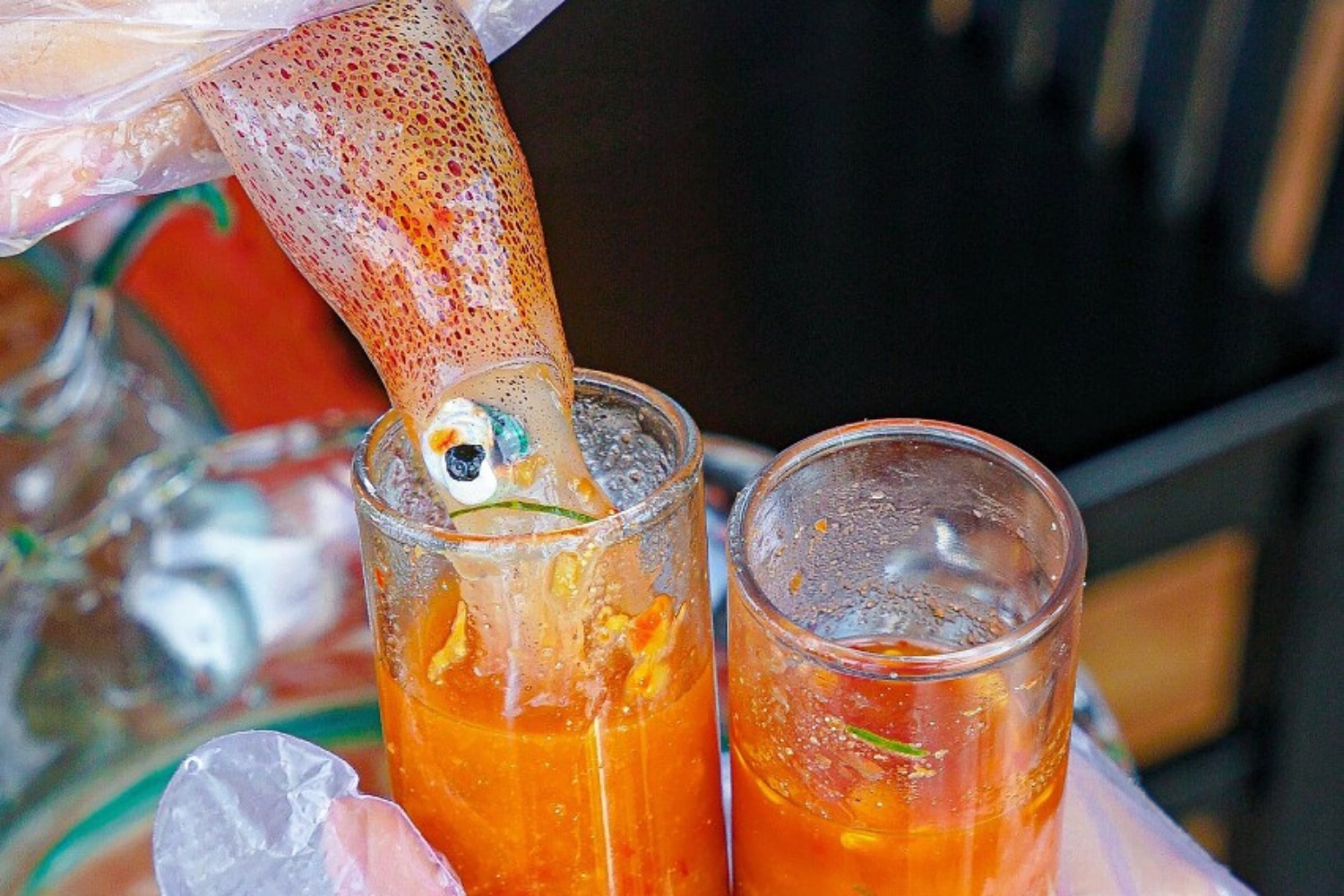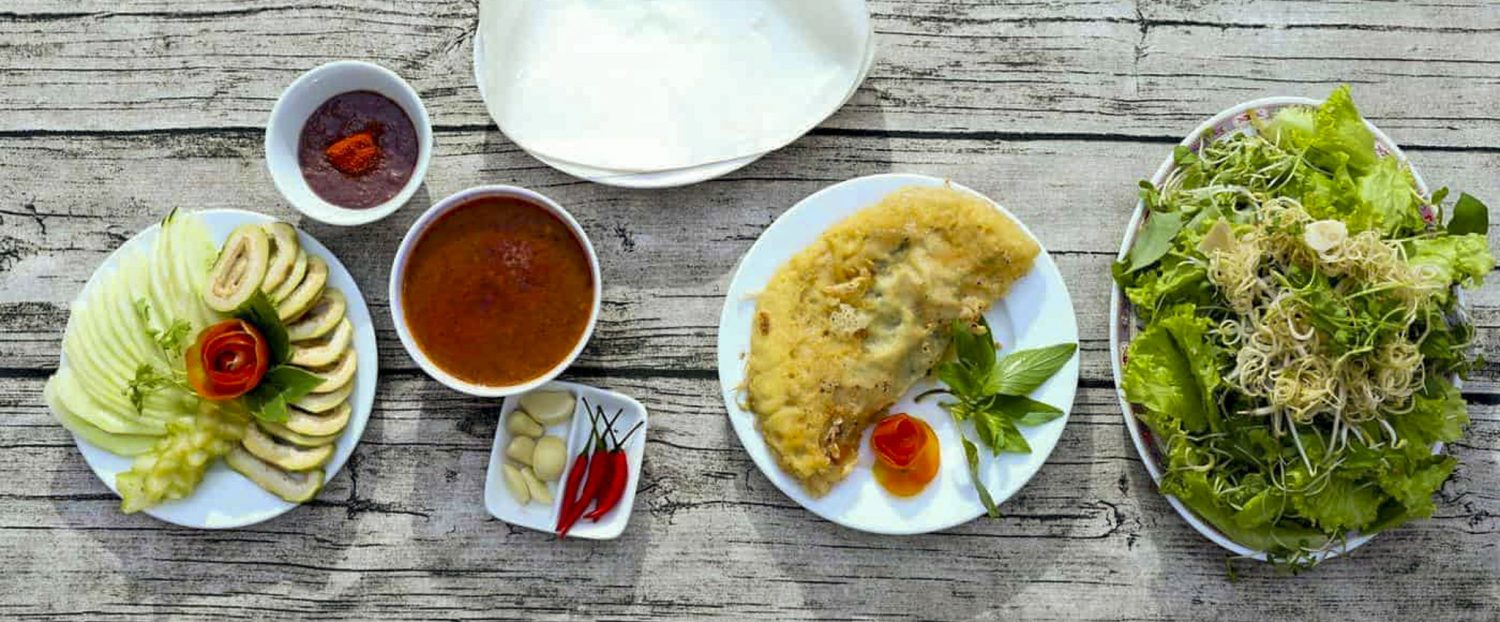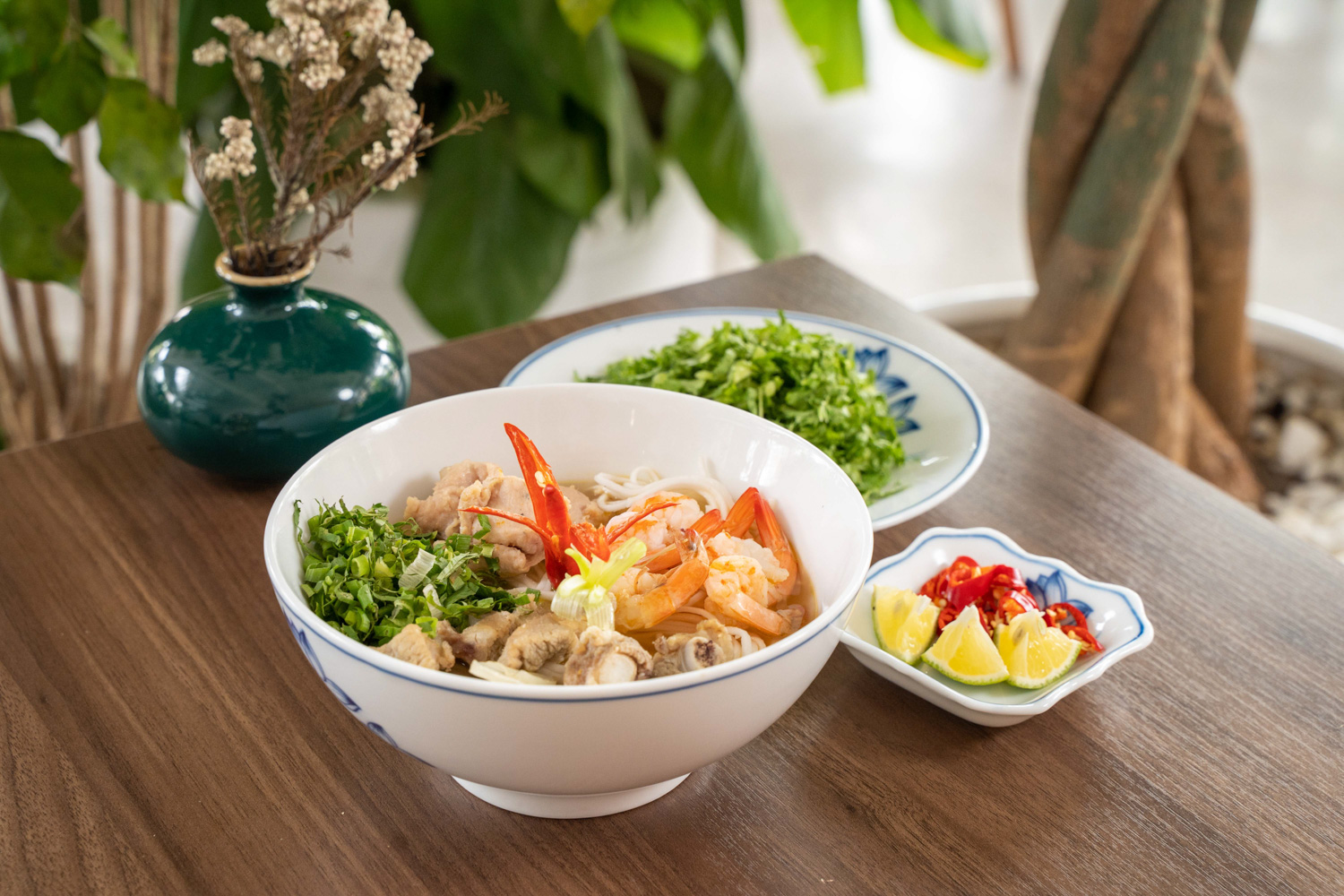Quang Binh is not only famous for its stunning natural landscapes but also attracts visitors with its diverse seafood cuisine, especially fresh and delicious seafood. Among them, jumping squid is one of the most unique and enticing dishes, captivating diners with its freshness and irresistible flavor.
Let’s explore jumping squid in Quang Binh – a one-of-a-kind culinary experience that brings visitors the essence of the sea.
What is jumping squid?
Jumping squid (Muc Nhay in Vietnamese) refers to live squid, usually the smaller type of squid rather than cuttlefish or broad squid, as bigger squid are suitable for eating raw. Jumping squid are caught near the shore, kept alive in seawater, and transported inland to ensure absolute freshness.
The name “jumping squid” comes from what it looks like when eating the squid. When taken out of the water, the squid remains alive and can still jump on the hand of the person holding it. This means the squid is exceptionally fresh.
In Quang Binh, there is another type of squid known as “shimmering squid” (also Muc Nhay in Vietnamese). These two types have slight differences:
– Jumping squid: Caught and kept alive before preparation.
– Shimmering squid: Freshly caught from the sea but not kept alive for long. Under light, their skin shimmers and glows, similar to flickering lights.

Jumping squid in Quang Binh
Quang Binh is an ideal location in Central Vietnam for finding jumping squid, with famous coastal areas such as Nhat Le and Bao Ninh. Fishermen usually catch squid at night, especially on calm sea days, using artificial bait to lure squid from the seabed.
Compared to regular fresh squid sold in markets or supermarkets, jumping squid has a firmer texture and stronger umami since it has not undergone any freezing process. This is why experiencing jumping squid always leaves a lasting impression on diners.
Dishes made from jumping squid in Quang Binh
Jumping squid in Quang Binh can be prepared in various ways, including steaming, grilling, stir-frying, or dipping in vinegar. However, the freshest and most flavorful options are live jumping squid in dipping sauce and sashimi.
Jumping squid in dipping sauce (squid shot)
Jumping squid in dipping sauce shares similarities with Japan’s “odorigui” style, which means “dancing while being eaten.” In Japan, this eating style is popular with certain small seafood like fish, shrimp, or baby squid. In Vietnam, particularly in coastal provinces like Quang Binh, Nghe An, Ha Tinh, and Quang Ninh, this dish has been adapted to suit local tastes.
The uniqueness of this dish lies in the live squid being dropped into a cup of tangy and spicy dipping sauce, typically garlic chili fish sauce or mustard. The squid wriggles before being eaten, creating a thrilling and fun experience for diners. When consumed, the squid may still move slightly in the mouth. Some people chew thoroughly to enjoy its firm and naturally sweet texture, while others swallow it whole. This way of eating makes it feel as if the squid is still swimming inside the stomach.

Jumping squid sashimi
If you aren’t familiar with eating whole live jumping squid, you can still enjoy its fresh flavor with jumping squid sashimi. Similar to odorigui, sashimi is a popular way to enjoy fresh seafood in Japanese cuisine, where the ingredients are sliced into thin pieces and served with soy sauce or wasabi. Jumping squid sashimi is a more delicate option.
The squid is cleaned, skinned, thinly sliced, and put on ice to maintain its sweetness. When eating jumping squid sashimi, diners can dip it in soy sauce, wasabi, or green chili salt, creating a harmonious combination of the squid’s umami and a spicy, tangy kick. Each bite delivers a crunchy, fresh taste, offering a refreshing seafood experience.

Tips for enjoying jumping squid in Quang Binh
To fully experience the unique flavor of Quang Binh’s jumping squid, you need to know how to choose fresh squid, prepare a delicious dipping sauce, and eat it the right way.
How to tell if the squid is fresh
To enjoy authentic jumping squid, the key is selecting the freshest live squid. First, observe the squid’s body color—fresh squid should be transparent, with shiny, iridescent skin. The eyes should be bright, not cloudy or leaking fluid. When touched, the squid’s body should be firm and elastic, not soft or emitting an unpleasant odor.
Before eating, the squid must be properly cleaned by rinsing it in saltwater or seawater to remove mucus and any impurities. Those with sensitive stomachs or seafood allergies should be cautious when consuming raw squid. If concerned about bacteria or parasites, opt for safer preparations such as steaming, grilling, stir-frying, or vinegar dipping.

How to make the dipping sauce
Jumping squid in Quang Binh is often paired with a spicy, tangy dipping sauce. A common recipe includes wasabi, green chili, salt, and lime or kumquat juice, with adjustments based on personal taste. In restaurants, the sauce may be specially prepared, sometimes featuring garlic chili fish sauce or other seasonings.
However, those with digestive issues or sensitive stomachs should be cautious when consuming strong spices like green chili and wasabi. Excessive amounts may cause stomach irritation, so it’s best to try a small amount first to ensure it suits your taste.

How to eat jumping squid
When enjoying jumping squid, gently lift the squid with your palm to avoid sudden movements or splashes. Avoid squeezing its body too hard or holding it by the tentacles or tail, as this may cause the squid to react more strongly.
The proper way to eat it is to place the squid directly into a bowl or glass of dipping sauce. Head first. In a few seconds, the squid will absorb the sauce, enhancing its flavor. Once it has soaked up the sauce, swiftly place it in your mouth to fully experience its fresh, crunchy texture along with the spicy, tangy flavors of the dipping sauce.

For an enhanced experience, jumping squid can be paired with cold beer, light wine, or ginger tea, which helps balance the flavors and aids digestion.
Where to eat jumping squid in Quang Binh?
If you want to enjoy authentic jumping squid in Quang Binh, Dong Hoi City is the ideal destination. Many restaurants here offer fresh seafood, scenic sea and river views, and spacious parking areas. The price of jumping squid ranges from 700,000 to 750,000 VND per kilogram—not cheap, but worth the experience.
Muc Nhay Restaurant
– Address: 49 Nhat Le, Bao Ninh, Dong Hoi, Quang Binh
– Opening hours: 9:00 AM – 10:30 PM
– Price per person: 300,000 – 400,000 VND
Muc Nhay Restaurant is a perfect spot for seafood lovers. Located on Bao Ninh Peninsula, just across the Nhat Le Bridge from Dong Hoi’s city center, the restaurant is easily accessible for both downtown visitors and those staying along Bao Ninh Beach.
The jumping squid here is selected fresh on-site, ensuring its original taste and texture, providing a unique culinary experience. The menu also features other delicious dishes such as steamed squid, stir-fried oysters with mushrooms, steamed babylon snails with lemongrass, and baby octopus salad with pennywort. The spacious, airy dining area offers a stunning view of Nhat Le Bridge, which lights up beautifully at night. Prices are reasonable and suitable for all guests. Since the restaurant is often busy, it’s best to reserve a table in advance for the best experience.

New Sake Restaurant
– Address: 121 Nhat Le, Bao Ninh, Dong Hoi, Quang Binh
– Opening hours: 6:30 AM – 10:30 PM
– Price per person: 200,000 – 300,000 VND
Located on the same Nhat Le Street as Muc Nhay Restaurant, New Sake Restaurant is another excellent place to enjoy fresh seafood in Dong Hoi. The restaurant has a spacious interior featuring brown brick and wooden decor, with an open view of the Nhat Le River—especially stunning at night.
The menu at New Sake Restaurant is diverse, offering local specialties such as tuna eyes, bummalo fish, and jumping squid. The dishes are well-presented with good flavors. Besides the popular jumping squid, the braised tuna eyes with pickled mustard greens are a must-try, boasting a savory and spicy taste that pairs perfectly with steamed rice. Prices at New Sake are slightly above average, but the quality makes it a worthwhile experience when visiting Quang Binh.

Even though it might seem intimidating for those unfamiliar with raw seafood, Quang Binh’s jumping squid offers a one-of-a-kind culinary adventure deeply rooted in Vietnam’s coastal cuisine. If you ever visit Quang Binh, don’t hesitate to try this fresh and flavorful dish to fully embrace the essence of the sea.





